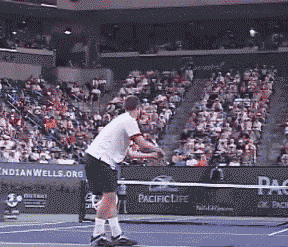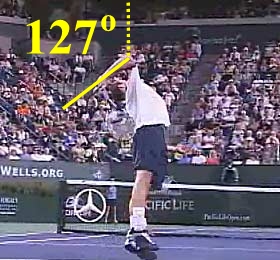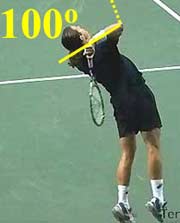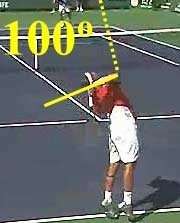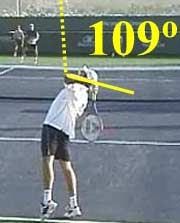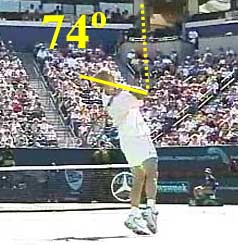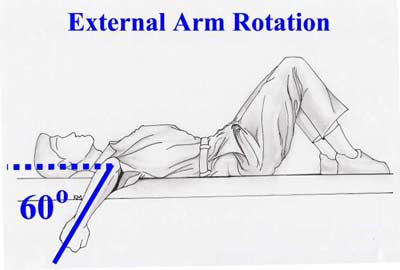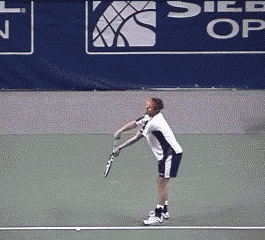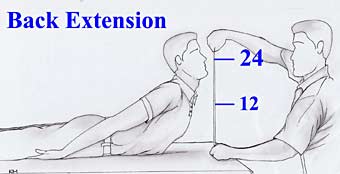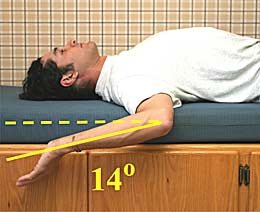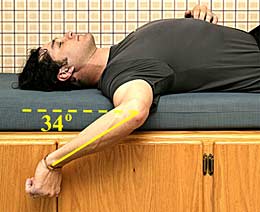|
TennisOne Lessons Andy Roddick’s 155 mph Serve Bob Prichard How is it that Andy Roddick can serve the ball at 155 mph? It’s a mystery. Look at Roddick. He doesn’t look that big, or muscular. Is there some secret to his serve? Is it just talent?
The reason we don’t understand Roddick’s serve is because our basic assumptions about sports are getting in the way of seeing what he is doing. Our basic assumption about sports is based on the Cartesian body-mind split. In sports, this body-mind split is expressed as the muscles-talent split. Everything in sport is muscles or talent. Muscles mean strength and endurance. Talent? Well, that's the big mystery, just as the mind is a big mystery. In other words, this split doesn’t really help us much to understand sports or life for that matter. At Somax Sports, we start with a different assumption. Sport is movement! Every sport requires movement. Movement requires flexibility, or Range. Range is the major aspect of movement, but there are others. They are Sequence, Separation, Speed and Alignment. Put together, the fundamentals of movement are RSSSA, or Russia, as we like to say. We will use this new assumption (sport is movement) and its corresponding new system of analysis (RSSSA) to look at Roddick’s serve. By the end of our analysis, we will show you that Roddick’s serve is not a mystery, but makes simple, obvious sense. It’s only faulty assumptions that make it seem like a mystery.
In this first article, we will just discuss range. In subsequent articles, we will discuss Sequence, Separation, Speed and Alignment. Range Range refers to the range of motion the joints go through during an athletic movement. We measure these ranges from videotape of the movement. All ranges are important, but some are more important than others. The most important range in the tennis serve is the external arm rotation, or the maximum number of degrees the arm rotates backward prior to hitting the ball. We calculate this range by measuring the angle of the forearm in relation to the ball. For Roddick, this range is 127 degrees. Why is this so important? Service speed is proportional to racquet head speed. The faster your racquet head is moving at impact, the faster the serve. It takes time and distance to get up to speed. The longer the time and distance, the greater your top-end speed. It’s the difference between a one eighth of a mile drag race and a one quarter of a mile drag race. The ¼ mile cars will be going much faster at the end of their race because they have had more time and distance to get up to speed.
At our clinic in Tiburon, CA, we have confirmed this relationship between external arm rotation (EAR) and service speed with a radar gun. As we improved the EAR of our tennis players, their service speed improved. How much it improved surprised even us.
For every degree a tennis player improved his EAR, he added a mile an hour to his serve! In other words, service speed doesn’t have much to do with muscles (strength and endurance) or talent — it is mostly due to flexibility in a specific range (EAR). Finally, Andre Agassi has a slower serve than the three player above. Again, Agassi does not have a slow service speed because of his size or age. His service speed is slow because he has a small EAR range. Once he sufficiently increases his EAR, he will be able to serve as fast as the others in this group. So then, the mystery of service speed is no longer a mystery. Since Range is so important to service speed, how much range do you need, how much range do you have now, and how do you get more range? To see how much range you have while serving, just videotape your serve and measure your External Arm Rotation in relation to the ball, just as we have done with Roddick and the other players. In this way, it will be easy to compare your range to theirs.
Now, what do you need to get Roddick’s service Range? First, you need flexibility in your shoulder joint. To serve like Roddick, you need at least 60 degrees of external arm rotation. To see what you have, just lie on a bed, put your serving arm out over the side of the bed at 90 degrees to your body, bend your elbow 90 degrees, and let your forearm drop back. Measure the number of degrees your forearm drops below the surface of the bed. Don’t be surprised if your EAR is zero (even with the surface of the bed) or even negative. Most tennis players find this range is really restricted.
Remember, 60 degrees is the minimum range you need for an efficient serve. If 60 degrees seems like a lot, we once worked with a javelin thrower who came to us with 60 degrees of EAR. After we released microfibers in his shoulder, his EAR increased to 90 degrees. He subsequently won his first Gold Medal. But you need more that good external arm rotation, because Roddick does something else during his service motion to increase his effective (as opposed to actual) external arm rotation. As you can see in his photo, he also leans over backward during his service motion. If he didn’t do this, his effective external arm rotation would be much less than it is. To arch your back like Roddick, you need good back extension. Athletes with good back extension can lie on their stomach, arms by their sides, and lift their nose a minimum of 24”. Try this at home and have someone measure your back extension with a measuring tape. If your EAR is less than 60 degrees, and your back extension is less than 24”, you will understand why your service speed is less than 155 mph. FLEXIBILITY = STRETCHING? Another mistaken assumption made by everyone (not just those in sports) is that stretching is the best and only way to improve flexibility. We find just the opposite to be true. Stretching is the least effective way to improve flexibility. For most people, stretching will improve their external arm rotation only a few degrees and increase their back extension only a couple of inches.
The reason for this is that most people, especially those who play sports, have developed microfibers in the connective tissue between their muscles. Microfibers are a mild form of scar tissue. These microfibers form as a result of stress. The stress that can be physical, such as injury (falls, impacts, or twists during sports, auto accidents, getting the wind knock out of you), overuse (hitting a lot of tennis balls, push-ups, pull-ups, lifting weights, running on court, carrying heavy backpacks), illness (bronchitis, colds, allergies) or mechanical (leg length differences). Anything that creates muscle soreness is a stress. The stress can also be mental (family, personal, or job stress). The stress does not have to be current or recent. It could have happened decades ago. All that is required is that you tensed your muscles in response to the stress. Whenever muscles tense, the connective tissue between the muscles thinks you have broken a bone and it immediately starts to form microfibers to bind the adjacent muscles together so that movement is reduced and healing can take place. Microfibers are nature’s internal cast. Unfortunately, once the stress has passed, the microfibers not only do not go away, they tend to accumulate over time, making us stiffer as we get older. As we get stiffer, our sports performance declines because our ability to move is restricted. And, as we know, sports are are all about movement. Microfibers cannot be released by stretching. As a result, most people find that they can stretch only so far. The assumption is that the remaining stiffness is due to our joints. But as with our assumptions about sport itself, this one is also wrong. Most people have full range of movement in their joints. What is restricting their range of movement are the microfibers in the connective tissue between their muscles.
Fortunately, these microfibers can be released and flexibility restored. This is done through Microfiber Reduction, a special form of connective tissue massage we have developed at Somax. Microfiber Reduction can improve flexibility far beyond what stretching alone can do. The tendency to form microfibers is genetic. Some people form them more readily than others. Some less. Roddick is in this latter group, as are most dominating athletes. Sam Snead, the golfer, was a good example. Sam was able to kick his spikes into the top of a doorframe into his 70’s. He also won more professional golf tournaments that any other player in history. Tom Seaver pitched into his 50’s. Photos show that he had a much greater range of motion in his hips that other pitchers. For the rest of us, Microfiber Reduction can level the playing field. By releasing microfibers, younger players can enjoy the same range of motion as their more genetically gifted opponents. For older players, it can reverse the stiffness that has come with age. But flexibility is only part of the equation. In addition to Range, you also need correct Sequence to fire a 155 mph serve. In our next article, we will describe an efficient sequence and show that Roddick alone, among top tennis players, has an efficient sequence in his serve. © Bob Prichard 2006 Your comments are welcome. Let us know what you think about Bob Prichard's article by emailing us here at TennisONE.
Bob Prichard is President of Somax Sports Corporation in Tiburon, CA. Its athletes have won 44 Gold Medals and set 11 World Records. Mr. Prichard can be contacted through the Somax Sports web site at www.somaxsports.com |

